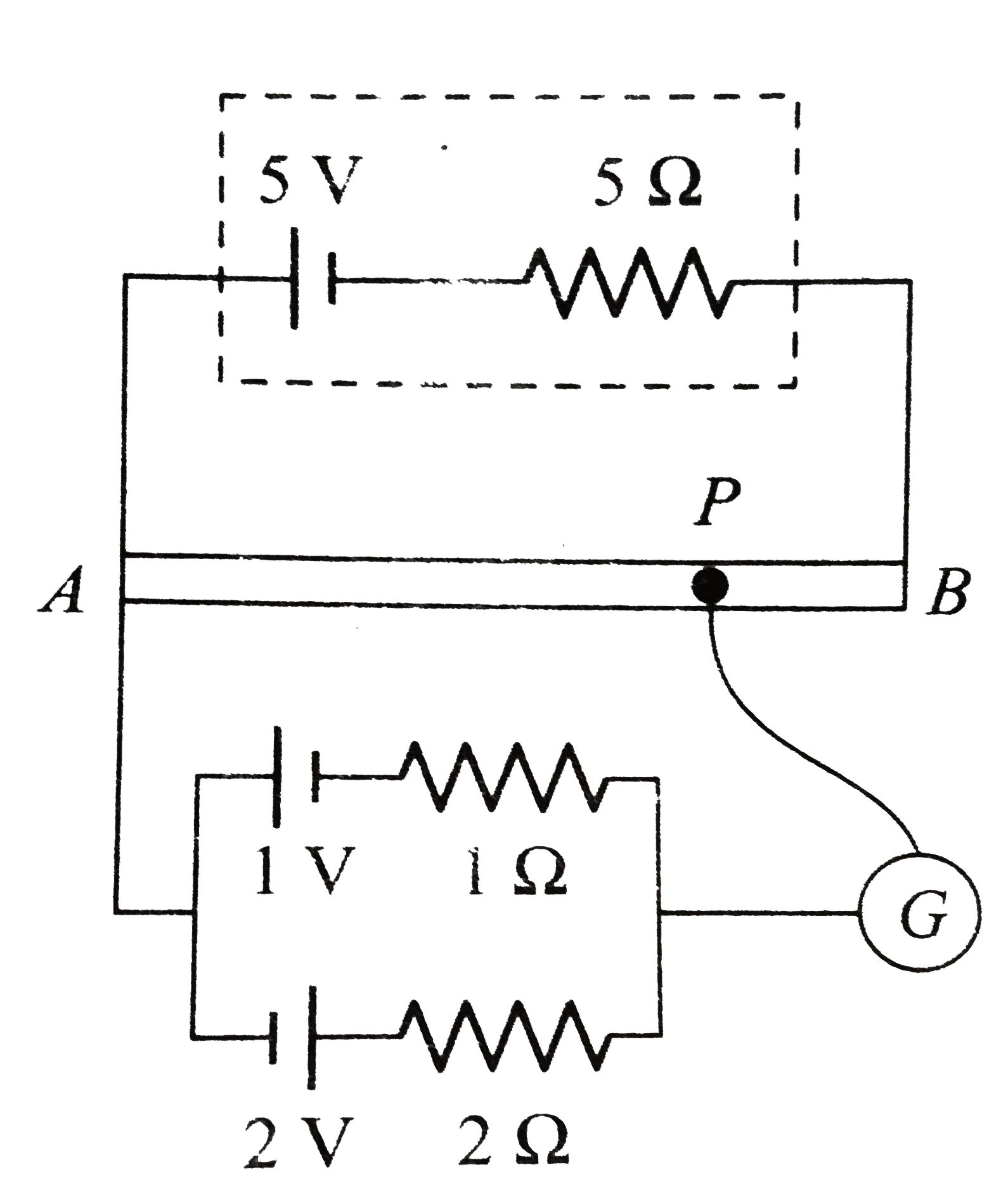A battery of emf ε0=5V and internal resistance 5Ω is connected across a long uniform wire AB of length 1m and resistance per unit length 5Ωm−1. Two cells of ε1=1Vandε2=2V are connected as shown in the figure.

the null point is at A.
If the jockey is touched to point B, the current in the galvanometer will be going towards B.
When jockey is connected to point A, no current flows through 1 V battery.
The null point is at distance of 8/15 m from A2.
The correct Answer is:A, B
a., b.
For null point, current flows in the
loop CD only.

i=3V2Ω+1Ω=1A
VCD=1V−1(1)=0
Therefore, option (a) is correct. That
is, VA>VB. When jockey touches B, current from A to B increases the
PD across the secondary circuit.
Therefore, option(b) is correct.
Similar Questions
Knowledge Check
A battery of emf 2 V and initial resistance 1Ω is
connected across terminals A and B of the circuit shown
in figure
 . AThermal power generated in the external circuit will be maximum possible when R=16/25Ω.BMaximum possible thermal power generated in the external circuit is equal to 4 W.CRatio of current through 3Ω to that through 8Ω is independent of R.DNone of above.
. AThermal power generated in the external circuit will be maximum possible when R=16/25Ω.BMaximum possible thermal power generated in the external circuit is equal to 4 W.CRatio of current through 3Ω to that through 8Ω is independent of R.DNone of above.A battery of emf E0=12V is connected across a 4m long uniform wire having resistance 4Ω/m. The cell of small emfs ε1=2V and ε2=4V having internal resistance 2Ω and 6Ω respectivley are connected as shown in the figure. If galvanometer shows no diflection at the point N the distance of points N from the point A is equal to
 A53mB43mC32mDnone of these
A53mB43mC32mDnone of these
A battery of emf ε0=10V is connected across a 1m long uniform wire having resistance 10Ω/m. Two cells of emf ε1=2V and ε2=4V having internal resistance 1Ω and 5Ω respectively are connected as shown in the figure. If a galvanometer shows no deflection at the point P, find the distance of point P from the point a.

View SolutionA battery of emf 2V and internal resistance 0.5(Ω)is connected across a resistance 1.5(Ω). Find the current flow through battery ?
View SolutionAn accumulator of emf 2V and negligible internal resistance is connected across a uniform wire of length 10 m and resistance 30Ω The appropriate terminals of a cell of emf 1.5V and internal resistance 1Ω is connected to one end of the wire and the other terminal of the cell is connected through a sensitive galvanometer to a slider on the wire. What is the length of the wire that will be required to produce zero deflection of the galvanometer? How will the balancing length change?
(a) When a coil of resistance 5Ω is placed in series with the accumulator.
(b) The cell of 1.5V is shunted with 5Ω resistor?
View SolutionAn accumulator of emf 2V and negligible internal resistance is connected across a uniform wire of length 10 m and resistance 30Ω The appropriate terminals of a cell of emf 1.5V and internal resistance 1Ω is connected to one end of the wire and the other terminal of the cell is connected through a sensitive galvanometer to a slider on the wire. What is the length of the wire that will be required to produce zero deflection of the galvanometer? How will the balancing length change?
(a) When a coil of resistance 5Ω is placed in series with the accumulator.
(b) The cell of 1.5V is shunted with 5Ω resistor?
View SolutionA secondary cell of emf 2 V and finternal resistance 0.1 Ω is connected to the ends of a uniform wire of length 1 m and resistacne 12 Ω.A primary cell of emf 1.5 V in series with a galvancometer is connected to two points on the wire. If the galvanometer shows no deflection find the distance between the points.
View SolutionA battery of emf E0=12V is connected across a 4m long uniform wire having resistance 4Ω/m. The cell of small emfs ε1=2V and ε2=4V having internal resistance 2Ω and 6Ω respectivley are connected as shown in the figure. If galvanometer shows no diflection at the point N the distance of points N from the point A is equal to

View Solution
